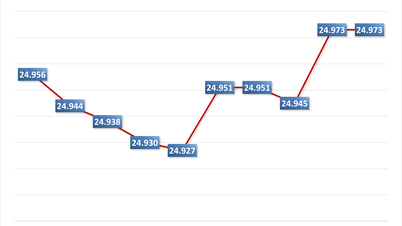 |
The greenback is headed for a fourth straight weekly loss as the dollar index hovers near a three-year low as President Donald Trump’s erratic tariff policies continue to drive investors away from U.S. assets. Trading could be quieter ahead of the Easter holiday.
The dollar recovered slightly from a seven-month low of 141.62 yen after Japanese Economy Minister Ryosei Akazawa confirmed that U.S.-Japan trade talks in Washington did not address currency issues. However, weakening confidence in the U.S. economy kept the dollar under pressure. Against the yen, the dollar was trading at 142.64 yen, up 0.54%.
The dollar has fallen sharply in recent weeks as the US administration has repeatedly threatened to impose and then unexpectedly delay wide-ranging tariffs, eroding investor confidence in the stability of the world's largest economy.
The Swiss franc, one of the top safe haven currencies, has risen 8% since the beginning of April, marking the biggest gain among the G10 currencies. The franc is currently trading at 0.8173 francs per dollar, down 0.49%, approaching a strong resistance zone at a decade high of 0.81 francs per dollar.
The euro has also gained more than 5% against the dollar in less than three weeks. Despite a slight 0.22% decline this morning to $1.1374, the euro is still on track for a fourth straight weekly gain, even as the European Central Bank (ECB) is expected to cut interest rates by 25 basis points at its upcoming meeting.
Despite US retail sales data recording the strongest increase in more than two years and Federal Reserve Chairman Jerome Powell remaining cautious about adjusting interest rates, selling pressure on the USD has shown no signs of abating.
Experts at Citi said this is not a true wave of de-dollarization, but at the same time warned: "The world is too concentrated in US assets, which could put serious pressure on the USD this year."
In a Citi report, the euro is forecast to peak at around $1.20 in the next six to 12 months, before the dollar can resume its upward trend.
The New Zealand and Australian dollars also made notable moves. The New Zealand dollar broke above both its 50-day and 200-day moving averages at $0.5922, although it did not gain much after higher-than-expected inflation data was seen as transitory.
The Australian dollar fell 0.2% to $0.6358 as investors awaited upcoming jobs data.
The British pound was steady at $1.3223, down 0.16 percent after the country's latest inflation data showed a lower-than-expected figure.
Source: https://thoibaonganhang.vn/sang-174-ty-gia-trung-tam-giam-6-dong-162910.html



![[Photo] Close-up of An Phu underpass, which will open to traffic in June](https://vphoto.vietnam.vn/thumb/1200x675/vietnam/resource/IMAGE/2025/5/15/5adb08323ea7482fb64fa1bf55fed112)






























































































Comment (0)